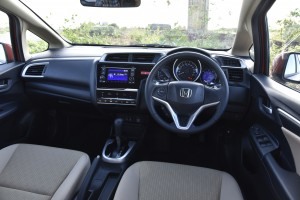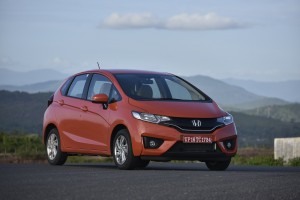We see what the new Jazz has to offer.
It may be an all-new model built on a new platform but the car remains easily identifiable as a Jazz; credit the trademark shape for that. Whether or not the fundamental design does it for you, there is plenty to keep you looking at the car. The large, angular headlights that merge into the multi-element grille look very attractive. Under the familiar glasshouse there’s a strong belt line that originates at the front doors and progressively widens towards the large tail-lights. Sadly, the mass of metal above the rear wheels does make the car look under-tyred. The tail, though, is smart and comes embellished with reflectors that flank the windscreen and a wide band of chrome that runs along the width of the tail-gate.
However, the thing that people will like the most is the car’s design for more practical reasons. An example is the tailgate that extends low on the bumper and the doors that open nice and wide for easier access. Inside, Honda Jazz is easily the most spacious car in its class with ample head, leg and shoulder room for five occupants. Passengers in the rear, though, will find the seat short on thigh support. The upward sloping floor (on account of the fuel tank being positioned under the front seats) may not be to everyone’s liking either.
 Interestingly, this time around, only top-spec models will get the ‘magic seats’ at the back. These seats split, fold flat and flip upwards to make space for all shapes and sizes of cargo – that’s if the massive boot won’t meet your needs. The seats also allow you to form a recliner by pushing the front seat backrests fully till they meet the rear seat base. It’s a unique feature the chauffeur-driven will love. Those likely to spend more time in the back will also like how the backrest angle can be adjusted (a segment first) on top-end variants. However, on the downside, the middle seat cushioning is firm and not very comfortable.
Interestingly, this time around, only top-spec models will get the ‘magic seats’ at the back. These seats split, fold flat and flip upwards to make space for all shapes and sizes of cargo – that’s if the massive boot won’t meet your needs. The seats also allow you to form a recliner by pushing the front seat backrests fully till they meet the rear seat base. It’s a unique feature the chauffeur-driven will love. Those likely to spend more time in the back will also like how the backrest angle can be adjusted (a segment first) on top-end variants. However, on the downside, the middle seat cushioning is firm and not very comfortable.
Up front, seat comfort is good but visibility past the chunky A-pillars is restricted and troublesome at crossroads. Otherwise, the car’s driving environment is very similar to the larger City’s. The chunky steering, the instruments and the basic layout of the centre console are all very similar. The car’s asymmetrical dashboard that comes finished in hard-wearing plastics extends further forwards towards the windscreen and the portion above the glovebox is more layered. Anyhow, with as many as nine cupholders and more than a few cubbyholes, the missing secondary compartment present on the old car won’t be missed.
 The Japanese automaker hopes that customers won’t find themselves shortchanged either. As unlike the lightly equipped 2009 Honda Jazz, the new one comes laden with features. There’s a colour display for the rear-view camera and infotainment system with a larger touchscreen unit offered on top variants. The touch-operated panel for the climate control system from the larger City also finds its way here and there are also steering-mounted buttons for audio and telephone functions. However, facts and figures will have to wait for now.
The Japanese automaker hopes that customers won’t find themselves shortchanged either. As unlike the lightly equipped 2009 Honda Jazz, the new one comes laden with features. There’s a colour display for the rear-view camera and infotainment system with a larger touchscreen unit offered on top variants. The touch-operated panel for the climate control system from the larger City also finds its way here and there are also steering-mounted buttons for audio and telephone functions. However, facts and figures will have to wait for now.
Source : Autocar India

